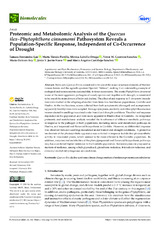Mostrar el registro sencillo del ítem
Proteomic and metabolomic analysis of the Quercus ilex–Phytophthora cinnamomi pathosystem reveals a population-specific response, independent of co-occurrence of drought
| dc.contributor.author | Hernández-Lao, Tamara | |
| dc.contributor.author | Tienda-Parrilla, Marta | |
| dc.contributor.author | Labella-Ortega, Mónica | |
| dc.contributor.author | Guerrero-Sánchez, Victor M. | |
| dc.contributor.author | Rey, María Dolores | |
| dc.contributor.author | Jorrín-Novo, Jesús V. | |
| dc.contributor.author | Castillejo-Sánchez, María A. | |
| dc.date.accessioned | 2024-02-12T12:41:29Z | |
| dc.date.available | 2024-02-12T12:41:29Z | |
| dc.date.issued | 2024 | |
| dc.identifier.issn | 2218-273X | |
| dc.identifier.uri | http://hdl.handle.net/10396/27439 | |
| dc.description.abstract | Holm oak (Quercus ilex) is considered to be one of the major structural elements of Mediterranean forests and the agrosilvopastoral Spanish “dehesa”, making it an outstanding example of ecological and socioeconomic sustainability in forest ecosystems. The exotic Phytophthora cinnamomi is one of the most aggressive pathogens of woody species and, together with drought, is considered to be one of the main drivers of holm oak decline. The effect of and response to P. cinnamomi inoculation were studied in the offspring of mother trees from two Andalusian populations, Cordoba and Huelva. At the two locations, acorns collected from both symptomatic (damaged) and asymptomatic (apparently healthy) trees were sampled. Damage symptoms, mortality, and chlorophyll fluorescence were evaluated in seedlings inoculated under humid and drought conditions. The effect and response depended on the population and were more apparent in Huelva than in Cordoba. An integrated proteomic and metabolomic analysis revealed the involvement of different metabolic pathways in response to the pathogen in both populations, including amino acid metabolism pathways in Huelva, and terpenoid and flavonoid biosynthesis in Cordoba. However, no differential response was observed between seedlings inoculated under humid and drought conditions. A protective mechanism of the photosynthetic apparatus was activated in response to defective photosynthetic activity in inoculated plants, which seemed to be more efficient in the Cordoba population. In addition, enzymes and metabolites of the phenylpropanoid and flavonoid biosynthesis pathways may have conferred higher resistance in the Cordoba population. Some enzymes are proposed as markers of resilience, among which glyoxalase I, glutathione reductase, thioredoxin reductase, and cinnamyl alcohol dehydrogenase are candidates. | es_ES |
| dc.format.mimetype | application/pdf | es_ES |
| dc.language.iso | eng | es_ES |
| dc.publisher | MDPI | es_ES |
| dc.rights | https://creativecommons.org/licenses/by/4.0/ | es_ES |
| dc.source | Biomolecules, 14 (2), 160 (2024) | es_ES |
| dc.subject | Quercus ilex | es_ES |
| dc.subject | Decline syndrome | es_ES |
| dc.subject | Climate change | es_ES |
| dc.subject | Markers of resilience | es_ES |
| dc.subject | Proteomics | es_ES |
| dc.subject | Metabolomics | es_ES |
| dc.title | Proteomic and metabolomic analysis of the Quercus ilex–Phytophthora cinnamomi pathosystem reveals a population-specific response, independent of co-occurrence of drought | es_ES |
| dc.type | info:eu-repo/semantics/article | es_ES |
| dc.relation.publisherversion | https://doi.org/10.3390/biom14020160 | es_ES |
| dc.relation.projectID | Gobierno de España. PID2019-109038RB-I00 | es_ES |
| dc.relation.projectID | Gobierno de España. PID2022-141599OB-I00 | es_ES |
| dc.relation.projectID | Junta de Andalucía. PROYEXCEL_00881 | es_ES |
| dc.rights.accessRights | info:eu-repo/semantics/openAccess | es_ES |

